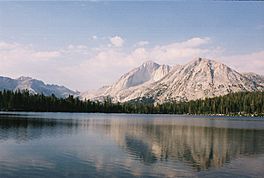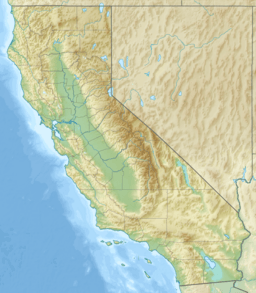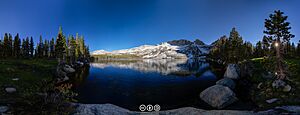Young Lakes facts for kids
Quick facts for kids Young Lakes |
|
|---|---|

Lower Young Lake, Yosemite National Park
|
|
| Location | Yosemite National Park |
| Coordinates | 37°53′52″N 119°20′51″W / 37.897851°N 119.347476°W |
Young Lakes are a group of three beautiful lakes located in Yosemite National Park, California. You can find them just north of an area called Tuolumne Meadows.
Exploring Young Lakes: What You Need to Know
If you're planning a trip to Young Lakes, here are some cool facts to help you prepare:
- The adventure starts at a place called the trailhead in Tuolumne Meadows. This spot is about 8,584 feet (2,616 m) high!
- As you hike, the highest point you'll reach on the trail is around 9,973 feet (3,040 m). Lower Young Lake itself sits at an elevation of about 9,880 feet (3,010 m).
- You'll gain about 1,389 feet (423 m) in elevation during your hike. This means you'll be climbing quite a bit!
- The total hiking distance to the lakes is about 6.4 miles (10.3 km).
- The best times to visit are during summer and fall. However, the amount of snow can change things, so always check with a park ranger before you go. They can tell you about current conditions.
- If you want to camp, there are special spots available:
- On the north side of Lower Young Lake.
- Near the Middle Lakes.
- On the northwest side of the Upper Lake.
- There are many fun things to do at the lakes, like Fishing, photography, exploring the area, and even climbing peaks nearby.
Location and Nearby Peaks
The Young Lakes are nestled between two impressive mountains: Ragged Peak and White Mountain.
You'll also see other amazing peaks close by, such as Sheep Peak, North Peak, and Mount Conness. The trail offers incredible views of many more distant mountains to the south, part of the stunning Cathedral Range.

All content from Kiddle encyclopedia articles (including the article images and facts) can be freely used under Attribution-ShareAlike license, unless stated otherwise. Cite this article:
Young Lakes Facts for Kids. Kiddle Encyclopedia.



